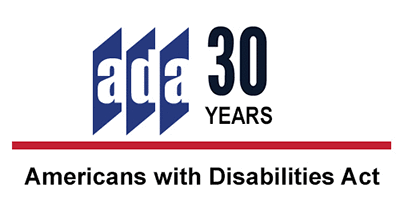
Image Source: ADA Anniversary
"People in wheelchairs are lonely people."
I remember like it was yesterday the first time my late father told me that. I posed an innocuous question to him about how in India (his place of origin), they were able to enjoy life outside their home without the accessibility laws that exist in America. For context, this was the mid-1990s, and the Americans with Disabilities Act (ADA) had only been in effect for a few years. While he commended the U.S. for passing progressive laws such as the ADA, he could not let go of his ingrained misconceptions about people with disabilities.
It was not, however, until 20 years later, when I joined the federal workforce, that I finally saw how the ADA had broken down so many barriers for my peers. When I started building relationships in my office, I saw—in real life—how many people with disabilities were not only the opposite of lonely but that they were some of the most fun-loving and kind people I have gotten to know in my life. I chuckle when I think of some of my fond memories of doing karaoke with one particular friend, that was proud that the city we were visiting supported accessible rideshare vehicles at late hours for people with disabilities who wished to enjoy the city’s nightlife. None of that would have been possible 30 years ago.
The ADA was signed into law on July 26, 1990, by former President George H.W. Bush. Designed to model the Civil Rights Act of 1964, the law intended to guarantee that people with disabilities have the same opportunities as everyone else in America, including education, employment, purchasing goods and services, and participating in federal, state, and local government programs and services.
Federal employees with disabilities have been covered since 1973 under Section 501 of the Rehabilitation Act; since then, language from the ADA (and subsequent Americans with Disabilities Act Amendments Act (ADAAA)) has been incorporated into the Rehabilitation Act, so federal employees are offered the same opportunities and protections that our non-federal peers enjoy.
As a Reasonable Accommodation (RA) practitioner, I use the ADA and Rehabilitation Act every day to give practical guidance to our stakeholders and help the NIH provide reasonable accommodations for employees with disabilities. I am grateful that so much has been developed since the 1990s in disability law, as it assists me as I consult with employees and supervisors about RA.
It is often hard to acknowledge that we may have been negatively influenced by parts of our upbringing. Every day I find myself fighting against biases, conscious or otherwise, about other people, including those with disabilities. I am grateful for laws like the ADA that have made our society one step closer to changing our collective mindsets, and I look forward to the next 30 years of disability legislation to continue challenging our preconceptions and furthering the journey to equity for people with disabilities.
Do you have a story idea for us? Do you want to submit a guest blog? If it's about equity, diversity, or inclusion, please submit to edi.stories@nih.gov.
For news, updates, and videos, follow or subscribe to EDI on: Twitter, Instagram, Blog, YouTube.






